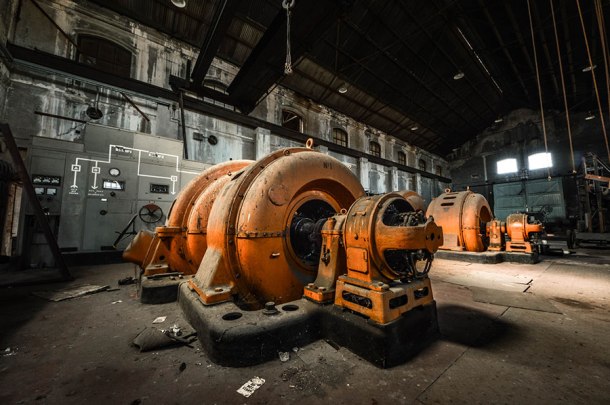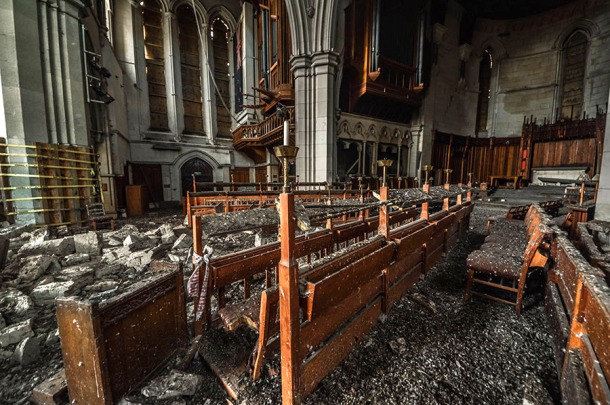Ruin photography embraces history and decay
In recent years, ruin photography, sometimes called “ruin porn”, has been gaining more and more interest, both from photographers themselves and from people whose curiosity in the subject matter makes the photos compelling viewing.
Ruin photography is essentially a fascination with urban decay. The photos look at buildings in the post-industrial world that have been abandoned and forgotten, are often dilapidated and, ultimately, are falling into ruin. Some of these buildings were once beautiful and extravagant, and the photography captures a sad sense of faded glory and despair. Some were enormous in scale and heavily industrial and utilitarian to begin with, and the photography captures an almost seedy and embarrassing sense of waste as outdated technology is left to rot.
Ruin photography also has the added sense of taboo, as photographers sometimes access the buildings illegally.
But ultimately, the allure of urban exploration has to do with the quest after how to get into a location, the curiosity of what will be found inside and the aesthetics of decay.
Queensland based underground photographer Vic Ortice has a passion for ruin photography.
Mr Ortice, who works under a pseudonym, takes photos in locations around Brisbane, the Gold Coast and in New Zealand of what could be described as “modern ruins” or “urban decay”.

When it comes to scouting for ruin photography locations, Mr Ortice said he found vacant properties, especially government properties, were best, because they usually “leave a lot behind”.
He said the appeal of ruin photography for him was in the exploration of history through the buildings he photographed and their state of decay.
However, Mr Ortice said he had an alternative theory as to why people are interested in viewing images of ruins, and said he believed it showed the planning failure of private and government contractors.
“Surprisingly, a lot of people are interested in beating the system and sharing the government’s corruption, through wasting taxpayers’ money that gets puts in facilities that are never complete or that just become outdated,” he said.
The HBO television mini-series Chernobyl, which was released in June this year, has also helped spark interest in ruin photography.
Slovenian travel agents have reported that interest in the HBO series has led to surge in the number of visitors to the exclusion zone, which is estimated to increase from 75,000 to more than 100,000 people this year, according to The Slovak Spectator.
It is not really surprising that the abandoned city of Pripyat and Chernobyl gained a lot of attention from photographers, including English photographer Darmon Richter.

Damon Richter is a travel writer and photographer who runs travel journal The Bohemian Blog.
Mr Richter said there was some times an unseen, contrived side to the photographing of ruins that the public didn’t perceive.
He said in his experience, the contents of buildings were often rearranged, resulting in an artificially created shot.
“This happens at pretty much every well photographed ruin in the world,” Mr Richter said.
Though Mr Richter said it was not the way he did things, he knew the practice was common among photographers.
“I know one certain high-profile ruin photographer who will spend as much as half a day rearranging the furniture inside an abandoned building for a single shot, and then sell those images under the claim that everything is just as they found it,” he said.
Mr Richter said this reconstruction of reality was especially the case in Pripyat.
He said it would be “naïve” to believe that the photographs taken inside the abandoned buildings there would give an authentic story.
Instead, Mr Richter said the audience should view these images as “a piece of art”, as they represented the photographer’s perception of the moment.
“No captured image can ever be unconditionally truthful,” he said.
Ruin photography also attracts amateur photographers and curious viewers, who usually share photos on platforms such as websites and social media.
These platforms allow users to join groups where they can post and access images with information regarding another element of fascination with ruin photography, which is the way the photographs document history.

American-born Jon Anderson administers a 38,000-member Facebook group that uploads images of abandoned places in Australia.
Mr Anderson said his fascination with ruin photography started with an interest in his family history.
He said after the death of his father when he was young, he began to research his family and discovered that his grandfather had owned gold mines in the Mojave Desert in North America.
After initially being told he’d never be able to visit the mines due to the site now being located on land belonging to China Lake Naval Air Weapons Station, Mr Anderson was eventually given permission by the army to tour areas of family significance at the base.
“On my second visit, I showed my guide a photo of my aunt and grandmother next to an old cabin in a canyon, and he said he knew where it was,” Mr Anderson said.
“ [A] couple hours later I had my photo taken standing almost exactly where my aunt stood some 70 plus years earlier.
“This connection had a real impact on me,” he said.
“It wasn’t just an old cabin, it was part of my family’s history.”
Mr Anderson used the images of ruined buildings shared with the group to learn about the history of Australia.
One group who see the merit in the preservation and documentation not just of ruins, but of buildings in general, are architects.

Architecture and ruins have a notable intertwined history, with the documented fascination with ruins beginning during the 18th century.
Adolf Hitler’s chief architect, Albert Speer, released an essay called “The Theory of Ruin Value” in preparation for Germany’s hosting of the 1936 Summer Olympics.
Karine Dupre, an associate professor of architecture at Griffith University, said in modern architecture this fascination with ruins was still present.
During her work as an architect she designed a new build that had a heritage-listed Roman wall on the property that the owner wanted to cover up.
Ms Dupre said she was able to convince the client to see the value of the wall “otherwise he would’ve… destroyed it”.
Ms Dupre said she believed older architecture was often seen as an obstacle to the building of “new age” structures on the Gold Coast.
She said old beach shacks were often demolished to make way for new developments, an attitude she described as “problematic”.
The Gold Coast had no heritage register until 2010, and Vic Ortice said in his experience most places on the Gold Coast got demolished “very quickly”.
As well as an architectural fascination, Ms Dupre said there was also an emotional aspect to opposing the destruction of these buildings, because their destruction means we lose the “traces of people” who were there before.
“When something so tangible disappears, you feel that this is the last traces of those people… so it is very emotional,” she said.













